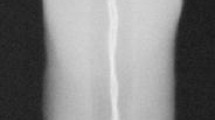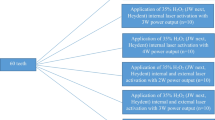Abstract
The purpose of this study was to evaluate the surface and intrapulpal temperatures after treatments with different bleaching gels subjected to different types of light activation. A K-type thermocouple and infrared thermometer were used to measure the temperature increase during the 15- or 30-min treatment period. Light-emitting diode with a center wavelength of 405 nm (LED405), organic light-emitting diode (OLED), and femtosecond laser were tested and compared to ZOOM2. The tooth surface was treated with five bleaching agents and Vaseline which served as a control.The generalized estimating equation (GEE) model was applied for testing the differences in temperature increase. The ZOOM2 light source led to the largest increase in mean pulpal and tooth surface temperatures of 21.1 and 22.8 °C, followed by focused femtosecond laser which increased the pulpal and surface temperatures by up to 15.7 and 16.8 °C. Treatments with unfocused femtosecond laser, LED405, and OLED induced significantly lower mean temperature increases (p < 0.001 for each comparison with ZOOM2 and focused femtosecond laser), both in the pulp chamber (up to 2.7, 2.5, and 1.4 °C) and at the tooth surface (up to 3.2, 3.4, and 1.8 °C). Significant differences between pulp chamber and tooth surface measurements were obtained for all types of bleaching gel, during treatments with ZOOM2 (p < 0.001), LED405 (p < 0.001), and unfocused (p < 0.001) and focused femtosecond laser (p ≤ 0.002). Different bleaching agents or Vaseline can serve as an isolating layer. Focused femtosecond laser and ZOOM2 produced large temperature increases in the pulp chamber and at the tooth surface. Caution is advised when using these types of light activation, while LED405, OLED, and unfocused femtosecond laser could be safely used.


Similar content being viewed by others
Abbreviations
- LED:
-
Light-emitting diode
- OLED:
-
Organic light-emitting diode
- PAC:
-
Plasma arch
- QTH:
-
Quartz–tungsten–halogen
- IR:
-
Infrared
- HP:
-
Hydrogen peroxide
- CP:
-
Carbamide peroxide
References
Uysal T, Basciftci F, Usumez S, Sarý Z, Bu¨yu¨kerkmen A (2003) Can previously bleached teeth be bonded safely. Am J Orthod Dentofac Orthop 123:628–32
Lima DA, De Alexandre RS, Martins AC, Aguiar FH, Ambrosano GM, Lovadino JR (2008) Effect of curing lights and bleaching agents on physical properties of a hybrid composite resin. J Esthet Restor Dent 20:266–73. doi:10.1111/j.1708-8240.2008.00190.x
Joiner A (2006) The bleaching of teeth: a review of the literature. J Dent 34:412–9
Magalhães JG, Marimoto AR, Torres CR, Pagani C, Teixeira SC, Barcellos DC (2012) Microhardness change of enamel due to bleaching with in-office bleaching gels of different acidity. Acta Odontol Scand 70:122–6. doi:10.3109/00016357.2011.600704
Abouassi T, Wolkewitz M, Hahn P (2011) Effect of carbamide peroxide and hydrogen peroxide on enamel surface: an in vitro study. Clin Oral Investig 15:673–80. doi:10.1007/s00784-010-0439-1
Markowitz K, Pashley DH (2008) Discovering new treatments for sensitive teeth: the long path from biology to therapy. J Oral Rehabil 35:300–15. doi:10.1111/j.1365-2842.2007.01798.x
Leonard RH Jr, Haywood VB, Phillips C (1997) Risk factors for developing tooth sensitivity and gingival irritation associated with nightguard vital bleaching. Quintessence Int 28:527–34
Eldeniz AU, Usumez A, Usumez S, Ozturk N (2005) Pulpal temperature rise during light-activated bleaching. J Biomed Mater Res B Appl Biomater 72:254–9
Zach L, Cohen G (1965) Pulp response to externally applied heat. Oral Surg Oral Med Oral Pathol 19:515–30
Seale NS, Wilson CF (1985) Pulpal response to bleaching of teeth in dogs. Pediatr Dent 7:209–14
Sulieman M, Addy M, Rees JS (2005) Surface and intra-pulpal temperature rises during tooth bleaching: an in vitro study. Br Dent J 199:37–40
Hein DK, Ploeger BJ, Hartup JK, Wagstaff RS, Palmer TM, Hansen LD (2003) In-office vital tooth bleaching: what do lights add. Compend Contin Educ Dent 24:340–52
Sulieman M, Rees JS, Addy M (2006) Surface and pulp chamber temperature rises during tooth bleaching using a diode laser: a study in vitro. Br Dent J 200:631–634
Klaus M (2006) Organic light emitting devices: synthesis properties and applications. Wiley-VCH, Weinheim
Baik JW, Rueggeberg FA, Liewehr FR (2001) Effect of light enhanced bleaching on in vitro surface and intrapulpal temperature rise. J Esthet Restor Dent 13:370–8
Baldissara P, Catapano S, Scotti R (1997) Clinical and histological evaluation of thermal injury thresholds in human teeth: preliminary study. J Oral Rehabil 24:791–801
Torres CR, Caneppele TM, Arcas FC, Borges AB (2008) In vitro assessment of pulp chamber temperature of different teeth submitted to dental bleaching associated with LED/laser and halogen lamp appliances. Gen Dent 56:481–6
Luk K, Tam L, Hubert M (2004) Effect of light energy on peroxide tooth bleaching. J Am Dent Assoc 135:194–201
Michida SM, Passos SP, Marimoto AR, Garakis MC, de Araújo MA (2009) Intrapulpal temperature variation during bleaching with various activation mechanisms. J Appl Oral Sci 17:436–9
Vandewalle KS, Roberts HW, Tiba A, Charlton DG (2005) Thermal emission and curing efficiency of LED and halogen curing lights. Oper Dent 30:257–64
Asmussen E, Peutzfeldt A (2005) Temperature rise induced by some light emitting diode and quartz-tungsten-halogen curing units. Eur J Oral Sci 113:96–8
Coelho RA, Oliveira AG, Souza-Gabriel AE, Silva SR, Silva-Sousa YT, Silva RG (2011) Ex-vivo evaluation of the intrapulpal temperature variation and fracture strength in teeth subjected to different external bleaching. Braz Dent J 22:32–6
Kabbach W, Zezell DM, Pereira TM, Albero FG, Clavijo VR, de Andrade MF (2008) A thermal investigation of dental bleaching in vitro. Photomed Laser Surg 26:489–93. doi:10.1089/pho.2007.2221
Weerakoon AT, Meyers IA, Symons AL, Walsh LJ (2002) Pulpal heat changes with newly developed resin photopolymerization systems. Aust Endod J 28:108–11
Hofmann N, Hugo B, Klaiber B (2002) Effect of irradiation type (LED or QTH) on photo-activated composite shrinkage strain kinetics, temperature rise, and hardness. Eur J Oral Sci 110:471–9
Buchalla W, Attin T (2007) External bleaching therapy with activation by heat, light or laser—a systematic review. Dent Mater 23:586–96
Wetter NU, Barroso MC, Pelino JE (2004) Dental bleaching efficacy with diode laser and LED irradiation: an in vitro study. Lasers Surg Med 35:254–8
Yazici AR, Khanbodaghi A, Kugel G (2007) Effects of an in-office bleaching system (ZOOM) on pulp chamber temperature in vitro. J Contemp Dent Pract 8:19–26
Coutinho DS, Silveira L Jr, Nicolau RA, Zanin F, Brugnera A (2009) Comparison of temperature increase in in vitro human tooth pulp by different light sources in the dental whitening process. Lasers Med Sci 24:179–85. doi:10.1007/s10103-008-0546-2
Gluskin AH, Ruddle CJ, Zinman EJ (2005) Thermal injury through intraradicular heat transfer using ultrasonic devices: precautions and practical preventive strategies. J Am Dent Assoc 136:1286–93
Uysal T, Eldeniz AU, Usumez S, Usumez A (2005) Thermal changes in the pulp chamber during different adhesive clean-up procedures. Angle Orthod 75:220–5
Knezevic A, Tarle Z, Meniga A, Sutalo J, Pichler G (2005) Influence of light intensity from different curing units upon composite temperature rise. J Oral Rehabil 32:362–7
Goodis HE, White JE, Andrews J, Wanatabe LG (1989) Measurement of temperature generated by visible light cure lamps in an in vitro model. Dent Mater 5:230–4
Batista RG, Barcellos DC, Borges AB, Gomes Tores CR (2011) Analysis of the pulp chamber temperature of teeth submitted to light activation with and without bleaching gel. World J Dent 2:23–7
Acknowledgments
This study was supported by the Ministry of Science, Education and Sports, Republic of Croatia (project no. 065-0352851-0410), and Croatian Science Foundation (Evaluation of new bioactive materials and procedures in restorative dental medicine).
Author information
Authors and Affiliations
Corresponding author
Rights and permissions
About this article
Cite this article
Klaric, E., Rakic, M., Sever, I. et al. Temperature rise during experimental light-activated bleaching. Lasers Med Sci 30, 567–576 (2015). https://doi.org/10.1007/s10103-013-1366-6
Received:
Accepted:
Published:
Issue Date:
DOI: https://doi.org/10.1007/s10103-013-1366-6




